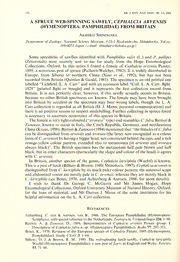
A spruce web-spinning sawfly, Cephalcia arvensis (Hymenoptera: Pamphiliidae) from Britain PDF
Preview A spruce web-spinning sawfly, Cephalcia arvensis (Hymenoptera: Pamphiliidae) from Britain
134 BR.J. ENT. NAT. HIST., 15:3/4;2002 A SPRUCE WEB-SPINNING SAWFLY, CEPHALGIA ARVENSIS (HYMENOPTERA: PAMPHILIIDAE) FROM BRITAIN Akihiko Shinohara Department ofZoology, National Science Museum, 3-23-1 Hyakunin-cho, Shinjuku-ku, Tokyo, 169-0073 Japan (e-mail: shiuoharig.kaliaku.go.jp) Some specimens of sawflies identified with Pcimphilius vcifer (L.) and P. pallipes (Zetterstedt) were recently sent to me for study from the Hope Entomological Collections, Oxford. In this series I found a female of Cephalcia cirvensis Panzer, 1805, a notorious pest ofspruce (Pschorn-Walcher, 1982). It is widely distributed in Europe, from Siberia to northern China (Xiao et cil., 1992), but has not been recorded from Britain (Quinlan & Gauld, 1981). The specimen is an old printed one labelled "Lichfield, L. A. Carr" and with an accession label "Coll. L. A. Carr. Bght. 1929" [printed Bght or bought] and it represents the first collection record from Britain. It is not perfectly clear, however, if this sawfly actually occurs in Britain, because no other British specimens are known. The female may have been brought into Britain by accident or the specimen may bear wrong labels, though the L. A. Carr collection is regarded as all British (D. J. Mann, personal communication) and there is no positive reason to suspect mislabelling. Furthercollecting in spruce forest is necessary to ascertain occurrence ofthis species in Britain. Thefemaleisverylight-coloured {"irrorata' type)and resembles C.fulvaBattisti& Zanocco, known to occur in Italy, the Czech Republic, Germany, and northeastern China(Kraus, 1998). Battisti&Zanocco(1994)mentionedthat"thefemalesofC.fulva can be distinguished fromcirvensis and irrorata (the latter now recognized as a colour formofC.cirvensis)byhavingabiggerhead,notconstrictedbehindtheeyes,andarich orange-yellow colour pattern, extended also to metanotum (in cirvensis and irrorata always black)". The British specimen has the metanotum half pale brown and half black, but in othercharacters (particularlythe shape and colour ofthehead) itagrees with C. cirvensis. In Britain, another species ofthe genus, Cephalcia lariciphiki (Wachtl) is known. Thisisa pest oflarch(Billany& Brown, 1980; Shinohara, 1997). Cephalciaarvensisis distinguished from C. lariciphiki by its much palercolourpattern; the antennal scape C andabdominal venteraremostlypalein cirvensis, whereastheyaremostlyblackin C. lariciphiki (see Benes, 1976, and Achterberg & Aartsen, 1986, for more details). I wish to thank Dr George C. McGavin and Mr James Hogan, Hope Entomological Collections, Oxford University Museum ofNatural History, Oxford, for the loan of material, and Mr Darren J. Mann of the same institution for his helpful information on the L. A. Carr collection. References Achterberg, C. van & Aartsen, van B., 1986. The European Pamphiliidae (Hymenoptera: Symphyta),withspecialreferencetotheNetherlands.Zoologische Verhandelingen234: 1-98. Battisti, A. & Zanocco, D., 1994. Biosystematics of Cephalcia arvensis Panzer group. I. Description ofCephalciafulva n. sp. (Hymenoptera Pamphiliidae). Reclia 11: 297-311. Benes, K., 1976. Revision ofthe European species of Cephalcia Panzer, 1805 (Hymenoptera, Pamphiliidae). Studie CSAVy. 1-68. Billany, D. J. & Brown, R. M., 1980. The web-spinning larch sawfly, Cephalcia lariciphiki Wachtl (Hymenoptera: Pamphiliidae), a newpest ofLarixin England andWales. Forestry 53: 71-80. BR.J. ENT.NAT.HIST., 15: 3/4;2002 135 Kraus, M., 1998. Einige fur Deutschland oder Bayern neue Blattwespen (Hymenoptera: Symphyta), pp. 35-41. In: Taeger, A., Blank, S.M. (Eds.), Pflanzemvespen Deutschlands (Hymenoptera, Symphyta). Kommentierte Bestandsaufnahme, Goecke & Evers, Keltern. Pschorn-Walcher,H., 1982.Pamphiliidae.pp.23-57.In:Schwenke,W.(Ed.),DieForstschddlinge Europas, 4, Haiitfliigler imdZweifliigler. Parey, Hamburg & Berlin. Quinlan, J. & Gauld, I. D., 1981. Symphyta (except Tenthredinidae), Hymenoptera, New Edition. Handbooksfor the identification ofBritish Insects 6 2(a): 1-67. Shinohara, A., 1997. Web-spinning sawflies (Hymenoptera, Pamphiliidae) feeding on larch. Bulletin ofthe NationalScience Museum (A) 23: 191-212. Xiao, G.-r., Huang, X.-y., Zhou, S.-z., Wu J. & Zhang, P., 1992. Economic Scnvfy Fauna of China (Hymenoptera, Symphyta). 226 pp. Tianze Eldonejo, Beijing. (In Chinese.) SHORT COMMUNICATION Dorcatoma dvesdensis Herbst (Col: Anobiidae) and its para—site Diospilus ephippium (Nees) (Hym: Braconidae) reared from Phellinus pomaceus. Examination of some brackets of the uncommon wood-decay fungus Phellimis pomaceus, 7.ii.l999, revealed a small number ofbeetle grubs. A section of the bracket was retained for rearing. Two adult Dorcatoma dresdensis Herbst were later found in the rearing chamber together with about 7 or 8 specimens of the parasitic wasp Diospilus ephippium (Nees). The brackets were characteristically on a blackthorn stem and the host bush was located in an old overgrown hedge. The location was Churn Bank, Elkstone, E. Glos (S091) and the hedge forms the upper boundary of an area of ancient wood pasture along the banks ofthe River Churn. This Nationally Scarce beetle has only once previously been reported from the county(Alexander, 1995), froma Ganoderma—adspersum bracket on anancientparish boundary beech at Rendcomb (SPOO) in 1994 a locality only five miles downstreain along the Churn Valley. This area appears to be a hot-spot in the county for the genus as D. flavicornis (F.) was reared in numbers from red-rotted heartwood ofa fallen oak branch gathered the same day a short distance downstream, the first record ofthis species for the county since 1919 (Atty, 1983). Singletons ofthe beetle Aderus oculatus (PaykuU) and an Eustalomyia anthomyiid fly also emerged from this material. Other species present at the site include Orchesia micans (Panzer), typically developingin brackets ofInonotushispidus on the old ash pollards in the—valley. This Orchesia is verywidespread in this fungus throughout the Cotswold Hills I know it from fourteen 10km squares in the county, mainly in old wood-pasture or ancient wood-edge situations. This is in marked contrast to O. undulata Kraatz which is confined to the larger ancient oakwoods and old parklands and the rarer O. minor Walker, which is also confined to the Cotswold ancient woodlands. Than—ks to Ted Green for finding the fungus and to Mark Shaw foridentifying the wasps. K.N.A. Alexander, 14 Partridge Way, Cirencester. Gloucester GL7 IBQ. References Alexander, K. N. A., 1995. Dorcatoma dresdensis Herbst (Coleoptera: Anobiidae) new to Gloucestershire. British JournalofEntomology andNaturcdHistory 8: 137. Atty, D. B., 1983. Coleoptera ofGloucestershire. Cheltenham, privately published.
